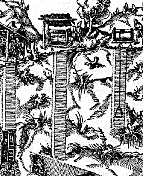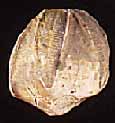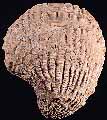Georg Bauer, better known by the Latin version of his name Georgius Agricola,
is considered the founder of geology as a discipline. His work paved the way
for further systematic study of the Earth and of its rocks, minerals, and
fossils. He made fundamental contributions to mining geology and metallurgy,
mineralogy, structural geology, and paleontology.
Born in Glauchau, in the province of Saxony in what is now Germany,
Agricola studied classics at Leipzig University, taught Latin and Greek
for a few years, and then in 1522 began to study medicine, first at Leipzig
and then at Bologna and Padua in Italy. He took his degree in 1526
and became a practicing doctor; however, he never
seems to have been terribly enthusiastic about his profession, devoting
most of his energy to studies of mining and geology. He began practicing
medicine at Joachimsthal in 1527. Joachimsthal was an important mining
center of the time, in particular for silver mining. Agricola's geological
writings reflect an immense amount of study and first-hand observation,
not just of rocks and minerals, but of every aspect of mining technology and
practice of the time. Agricola moved in 1536 to the city of Chemnitz,
also an important center of the mining industry,
and was elected Burgomaster there in 1546. He not only continued his medical
practice and his geological studies there, but was appointed to several
public and diplomatic posts by Duke Maurice of Saxony, to whom he dedicated his
book De Natura Fossilium. He died in 1555, one year before the
posthumous publication of De Re Metallica, his greatest work.
 De Re Metallica,
literally translated, means "On the Nature of
Metals," but the word metal had a wider meaning at the time, and meant
any mineral. In this book, which remained the standard text on mining for
two centuries, Agricola reviewed everything then known about mining, including
equipment and machinery, means of finding ores -- he rejected the use of
divining-rods and other such magical means -- methods of surveying and digging,
assaying ores, smelting, mine administration, and even occupational diseases
of miners. The book also contains descriptions of ores and of strata. His book
was profusely illustrated; one illustration, showing mine shafts, is shown
at left (click on the small image to view an enlargement).
Agricola noted that rocks were laid down in definite layers, or strata, and
that these layers occurred in a consistent order and could be traced over
a wide area. This observation of Agricola's was one of the first contributions
to stratigraphic geology, and one that would become important in
understanding the arrangement and origins of the rocks of the Earth.
De Re Metallica,
literally translated, means "On the Nature of
Metals," but the word metal had a wider meaning at the time, and meant
any mineral. In this book, which remained the standard text on mining for
two centuries, Agricola reviewed everything then known about mining, including
equipment and machinery, means of finding ores -- he rejected the use of
divining-rods and other such magical means -- methods of surveying and digging,
assaying ores, smelting, mine administration, and even occupational diseases
of miners. The book also contains descriptions of ores and of strata. His book
was profusely illustrated; one illustration, showing mine shafts, is shown
at left (click on the small image to view an enlargement).
Agricola noted that rocks were laid down in definite layers, or strata, and
that these layers occurred in a consistent order and could be traced over
a wide area. This observation of Agricola's was one of the first contributions
to stratigraphic geology, and one that would become important in
understanding the arrangement and origins of the rocks of the Earth.
Agricola also wrote the first book on physical geology, De Ortu et
Causis Subterraneorum (1546), notable for its descriptions of wind and
water as powerful geological forces, and for its explanation of earthquakes
and volcanic eruptions as produced by subterranean vapors and gases heated by
the Earth's internal heat. However, his greatest contribution to paleontology
was his book De Natura Fossilium (On the Nature of
Fossils), also published in 1546. This book
is not restricted to what we call fossils today: the Latin word fossilis
meant anything dug out of the ground, and Agricola's book included descriptions
of all kinds of minerals, gemstones, and even gallstones, in addition to what
we would call fossils now. Agricola's work summed up what the ancient Greek and
Roman authors had written about minerals, and included a list of a hundred
ancient authors whose works Agricola had consulted -- but Agricola was not
afraid to contradict the ancients' opinions if they did not fit with his
own experience. His work represented a major advance over previous writings
on rocks and minerals in that it classified them, not alphabetically or by
their supposed mystical powers, but by simple physical properties: "Thus
minerals have differences which we observe by color, taste, odor, place of
origin, natural strength and weakness, shape, form, and size." Agricola
gave standardized names to various minerals, and not only recorded their
appearance but the localities where they could be found. He also noted
how the same fossils might have different colors and appearances in different
places. Although Agricola's work included no pictures, his descriptions of
fossils are often instantly recognizable:
 "Lapis judaicus. . . usually occurs in the form of symmetrical acorns.
Prominent lines run from the blunt to the pointed end and these are so
regular they appear to have been made in a lathe and resemble the striae
on a shell. The people who call this mineral pyren liken these lines
to the bones of a fish that extend from the back down to the belly. . . When
split open it is light inside and glistens like marble and in some cases the
outside also has a high luster."
"Lapis judaicus. . . usually occurs in the form of symmetrical acorns.
Prominent lines run from the blunt to the pointed end and these are so
regular they appear to have been made in a lathe and resemble the striae
on a shell. The people who call this mineral pyren liken these lines
to the bones of a fish that extend from the back down to the belly. . . When
split open it is light inside and glistens like marble and in some cases the
outside also has a high luster."
 "Certain rocks, when split open, are found to contain shells; for example,
the conchites beds of Megara and the rocks of France. . .
Ostracites is a stone that takes its name from ostreum [oyster]
which it resembles. There are two species, the larger found in the moat on the
north side of Hildesheim. . . The smaller species is found not far from
Hanover on a cliff near the village of Linda in an unctuous light green
earth. . . . It forms in strata that are conspicuous. When
tapped with the finger it has the sound of a jug."
"Certain rocks, when split open, are found to contain shells; for example,
the conchites beds of Megara and the rocks of France. . .
Ostracites is a stone that takes its name from ostreum [oyster]
which it resembles. There are two species, the larger found in the moat on the
north side of Hildesheim. . . The smaller species is found not far from
Hanover on a cliff near the village of Linda in an unctuous light green
earth. . . . It forms in strata that are conspicuous. When
tapped with the finger it has the sound of a jug."
Agricola noted the resemblance of many of his "fossils" to living organisms,
but rarely stated that any of his fossils actually did represent
once-living organisms. The question of whether fossils did represent
once-living organisms was still debated in Agricola's time, and was not
finally resolved until the early 18th century, after the work of scientists
like John Ray and Robert Hooke.
While Agricola rejected some of the popular superstitions of his time, he
listed the medicinal and even magical uses to which rocks, minerals and
fossils were put: powdered lapis judaicus (the
blastoid
echinoderm Pentremites)
was prescribed for kidney stones, while ostreites (fossil oyster shell),
moistened with water, "reduces inflammation of the breasts, heals ulcers and
is poisonous to crawling insects." Nevertheless, Agricola's work was
important for the development of geology and paleontology as scientific
disciplines, for its classification by physical properties and localities,
its simple standardized naming system, its careful summarization of previous
work, and above all its use of observation and personal experience.
There is another Agricola page
maintained at the University of Bologna, Italy, with more detailed information
about Agricola's life and work (mostly in Italian at this time).
More pictures from
De Re Metallica are also available. And the city of
Chemnitz
(known as Karl-Marx-Stadt from 1953 to 1990)
recently celebrated Agricola's 500th birthday and presented some
information (in
German) on his life.











